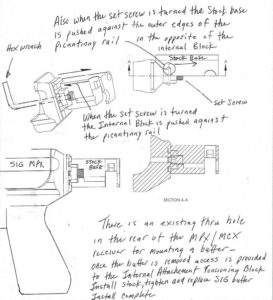By Ben Langlotz
|
July 14, 2016
|
Firearms
|
0 Comments
New Gun Inventions
(But Can’t Reveal…Until Now)
The best thing about my job is being on the inside and able to see all the new inventions in our industry. Sometimes I see some amazing things that I think might just cause revolutionary changes.
The worst thing about my job is that I have to keep my mouth shut. Those who know me know I love to chew the fat, and I write this newsletter as one way to get things off my chest. So this month’s issue is a first: I reveal the deepest secrets of some of my clients.
With their permission, of course!
Earlier this year, I realized that I have a sub-group of particularly special clients. I call them the “gold dust” list because of how important and valuable they are. They are the clients (usually new ones, often first time patent applicants) who are “patent pending” with a provisional application. I came to realize that I could help them much more than simply sending an automatic form email after nine months telling them they have three months to decide about making the major investment in a full patent application.
Instead of just waiting and wondering if their invention would make sense to patent, I realized that I could actually help them increase the odds that their invention would genuinely justify investing in patent protection. I love to see my clients succeed, and I welcome the chance to undertake a good project. So I asked myself: “How can I help these inventors and their inventions to actually become more clearly ready for patenting?”
One secret is that those on this privileged “gold dust” list have more than a little leeway to contact me at no extra charge, and get my advice on making their product successful. I might provide advice on business, marketing, and negotiating. This month’s newsletter is one way I’m helping several clients with marketing. I’m exposing their ideas to thousands of industry leaders like you, which might lead to developing contacts and relationship with potential licensees, investors, advisors, customers, and partners.
As I tell new clients who worry about secrecy: “For every venture that fails because of a secrecy breach, there are 99 that failed because they never got noticed.” So while I cautioned my “gold dust” list about the risks of revealing their inventions when I sent out the invitation to participate in this, I told them that most of them would stand to gain a net benefit.
I don’t identify all the players here, but am happy to put readers in touch with the inventors if there might be a benefit. Remember that all of these are “patent pending” inventions, so the inventors are the “First-to-File”. Their rights are secured, and I would never advise anyone to reveal an invention to the public until it was “patent pending.”
A Pistol with a new look

A Toothy Bite
You may have seen Honor Defense’s new pistol at the NRA show. It has a host of notable features, but the one that jumps out is that “underbite” look. After generations of pistol designers trying to maximize barrel length while minimizing overall size, this one breaks the rules. The protruding frame helps to prevent the slide from being pushed out of battery. This can occur if the gun is pressed against a barrier, or if a close-range bad guy grabs at the gun to push the slide back to disable the gun.
One key decision in cases where we have a new-looking invention is whether to protect the look with a design patent. Almost invariably, the answer is that if we think we can get a utility patent, we go that direction, because utility patents can protect a concept (like having a frame protruding beyond the barrel or slide, regardless of what it looks like) while a design patent will protect that particular look, and not alternative looks that provide the same function. They each have their place, but in this case the client is going for utility patent protection, which enables us to reserve rights with a provisional patent application.
While you’re admiring the drawing, note those slide serrations that wrap over the top. It’s always the top corner of serrations that serrate my hand, so this one might be a little easier on tender flesh without compromising grippability in a critical situation.
Another Fore-grip, with a twist

Variable Angle Foregrip
You don’t always need to have a working model to get a patent, but this one has a great prototype, shown here and in the patent application. Nothing too pretty or finished, but I had the chance to feel for myself how well it worked. The inventor saw a problem with vertical foregrips not providing an optimal angle, and decided that he needed one that would have lateral angular adjustment.
This one uses a simple mechanism in which the lower grip is attached to a bolt that extends from a ball. A cup or socket on the upper end of the grip mates with the ball. Just untwist to loosen, set the angle, and twist tight to provide a rock solid grip.
It’s a clean and simple design that works. Will the marketplace see the need for this adjustable angle feature? Time will tell, but the early signals are good.
How to SOLIDLY attach a stock to a SIG MPX

Real-World Provisional Patent Drawings
This one took left me scratching my head until I fully understood all the forces and features in the CAD drawings. The MPX has a little vertical segment of rail at its rear end. So you can clamp a stock or adapter on there to attach a stock. But with that short rail segment, and the force that can be applied to a stock, a typical rail clamp might not hold up.
So Safety Harbor Firearms came up with the idea that instead of clamping two side of a clamp together, they could have a “clamp” with fixed jaws, and then create an opposing force on the center of the rail that pulls the clamps away from the rail. This effectively “crushes” the rail in a way that generates a solid mount. If you’re trying to figure out the drawing, the set screw nose presses against the mount, while the compression block is threaded to the set screw to press against the rail face as the screw is tightened. This tightly pulls the jaws rearwardly against the edges of the rail.
What’s also nifty is that the method for attaching the mount involves using a simple Allen wrench from the rifle side of things right through a hole that SIG conveniently provided!
Another Shot Analyzer?
There are a number of shot analyzers that monitor movement of a pistol before and after a shot to help the user (or designer) identify any performance concerns. They can be engineering tools or training tools. This provisional patent filing didn’t need much in the way of drawings, with some looking like a simple min0can for mounting on the muzzle. The electronic block diagram reminded me of my old days when I help patent electronic circuitry for Silicon Valley companies (guns are much more fun).
For a good provisional, we include as much detail as possible. Here’s one passage:
The device uses two 3 axis accelerometers with each accelerometer selected for their ability to detect different levels of G force. One accelerometer will be a normal G range accelerometer set on more sensitive acceleration mode. This will enable the apparatus to detect subtle movements that occur before the pull of the trigger and the movement as the firearm returns to battery after the recoil has been absorbed. The second accelerometer will be a high G shock one used to measure the movement cause by recoil from the firing of the firearm. The high recoil of firearms tends to saturate the normal G range accelerometers making them useless as measuring devices when the firearm is firing.
That kind of detail means that down the road we can claim those concepts in the full patent application, if they prove to be the key to patentability.
A Convertible Bullpup

New lower fits standard and Bullpup uppers
Did you ever wish that you could have an upper receiver that could connect both to a standard AR lower and also to a bullpup lower? Not every invention answers questions that everyone’s been asking. Sometimes the boldest inventions are in uncharted territory. But a bullpup lower that works with standard uppers would mean that AR owners would multiply all the potential configurations of their collection.
Spend some time with the images and see it you can make sense of it. I’m looking forward to writing the full patent application so I finally get a chance to dig into all the details and fully understand this creation.
If you have any comments, questions, or serious business inquiries, feel free to contact me and I’ll put you I touch with my clients. If you think that one of these things is unpatentable because of some prior art you’re aware of, we’d welcome your sending us a copy, because it can only help my clients make the right decisions, and get stronger patents where appropriate. While I can’t possibly publish everything, if you’d like to see your invention here, let me know and future issues may continue this pattern if the response is good.